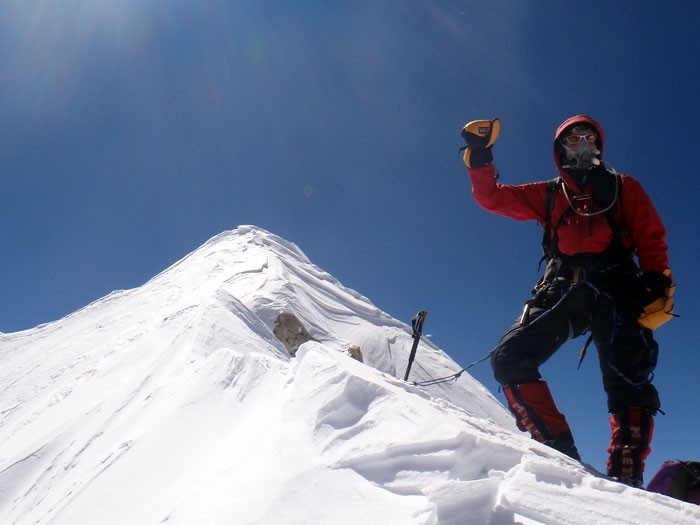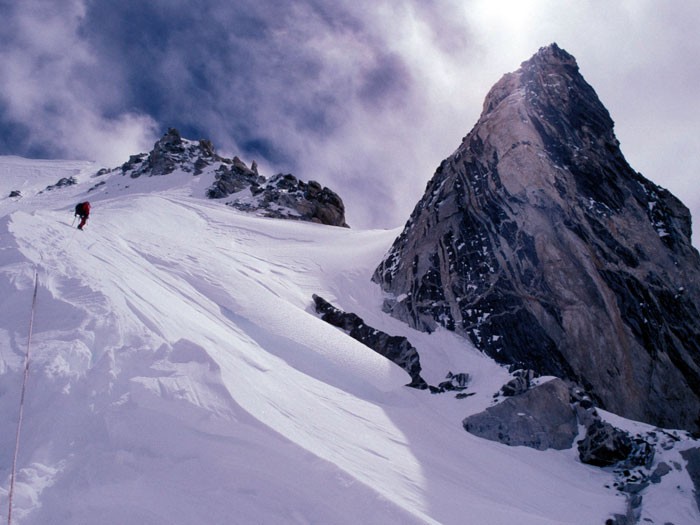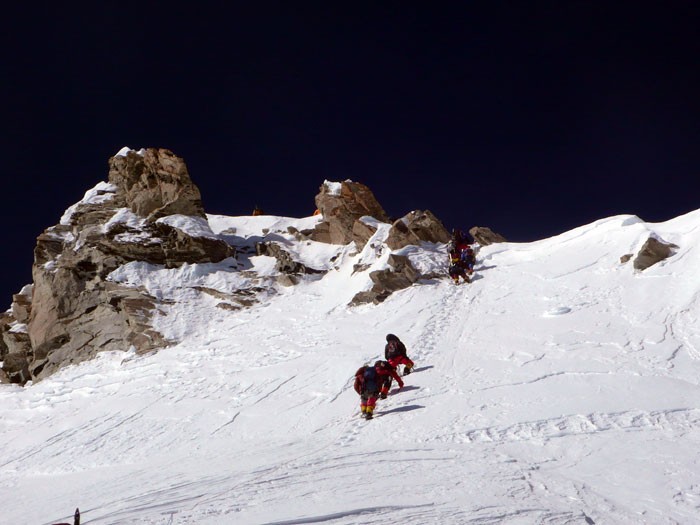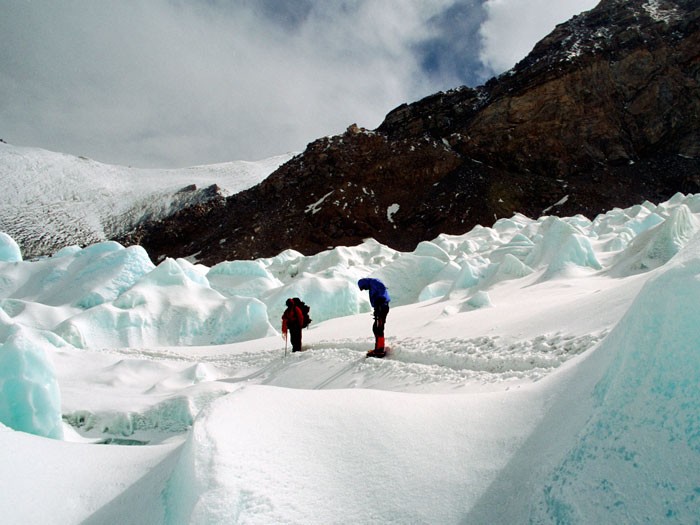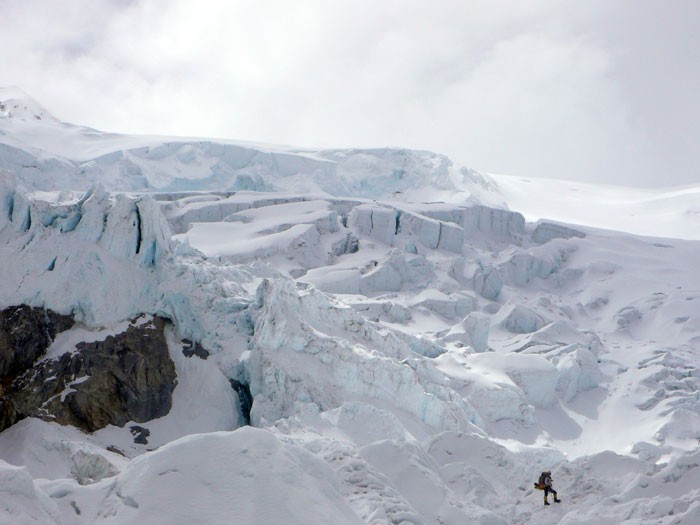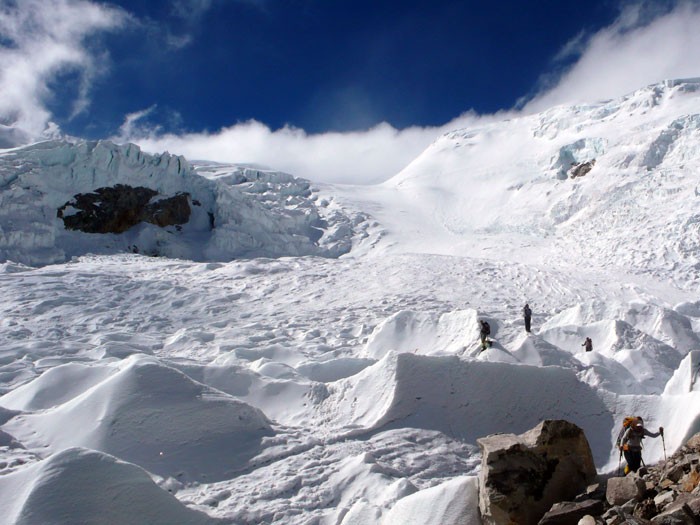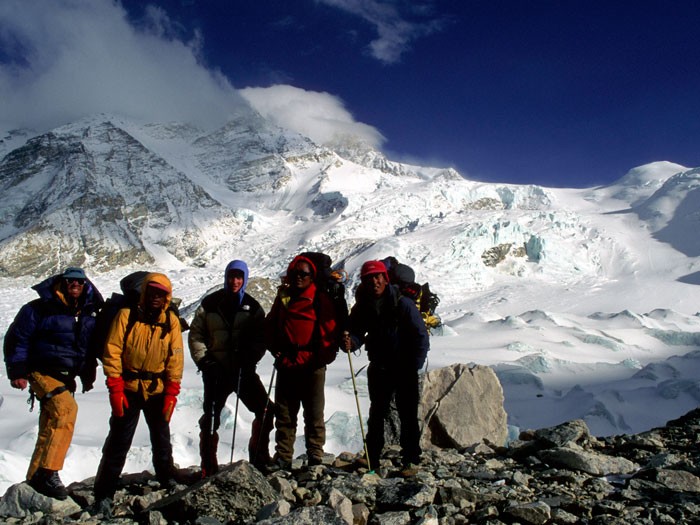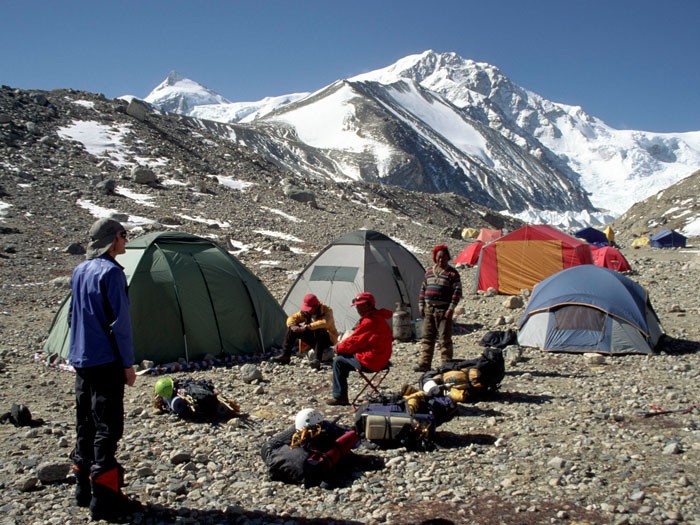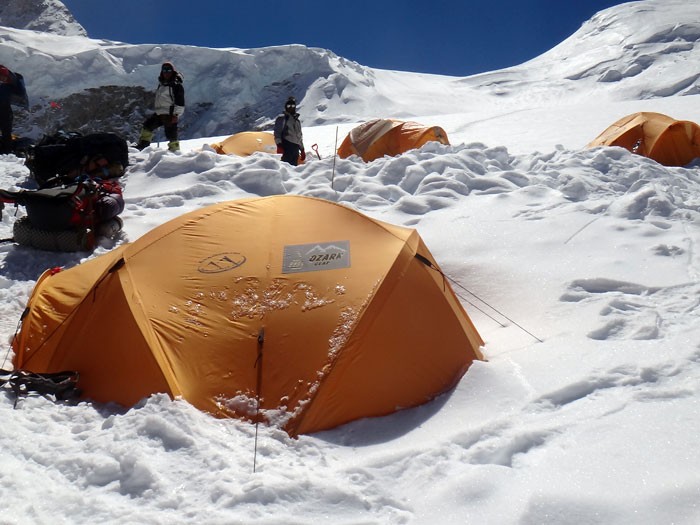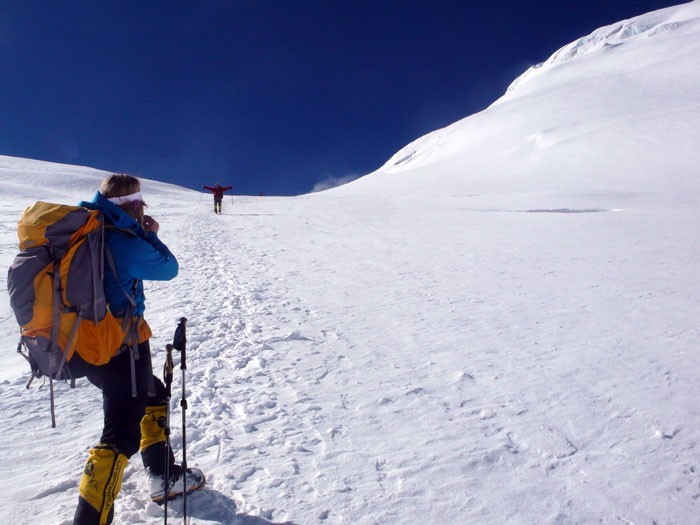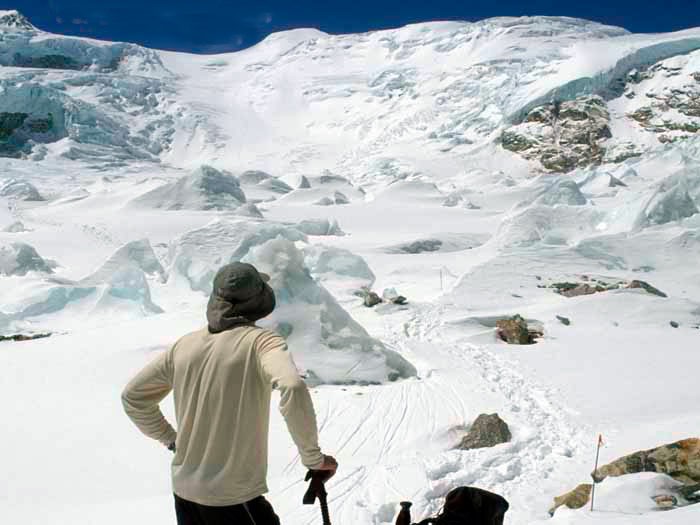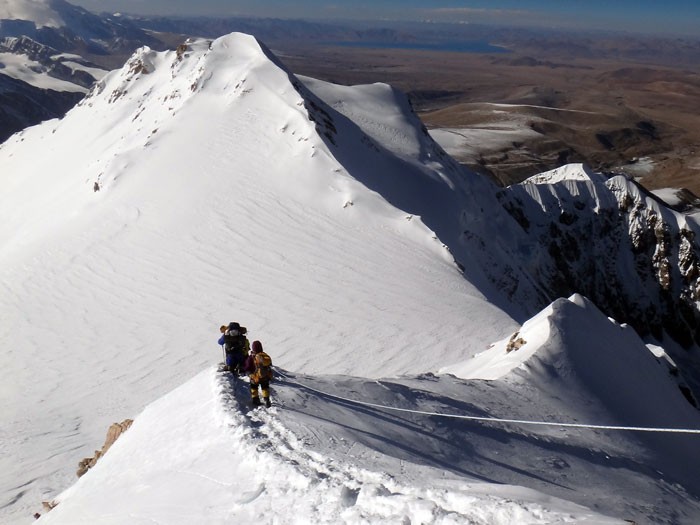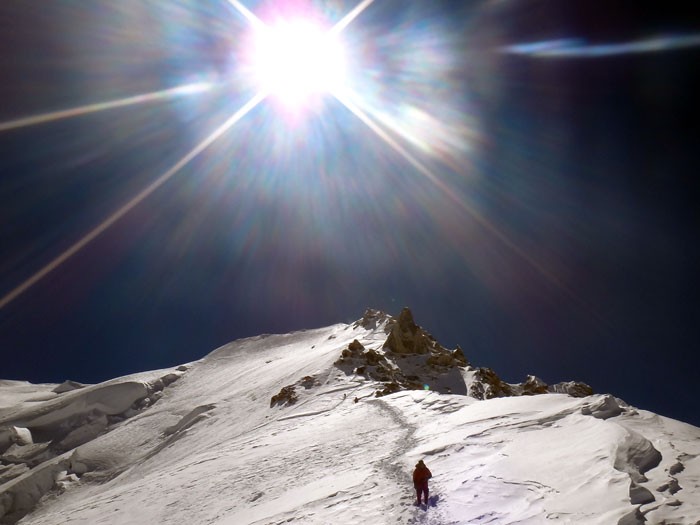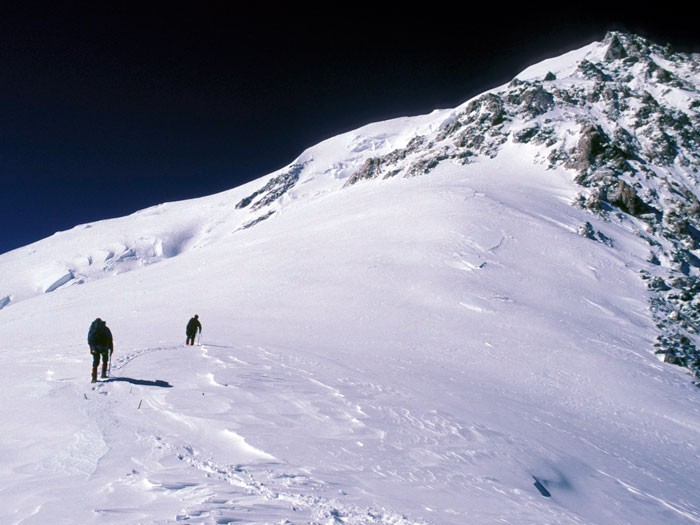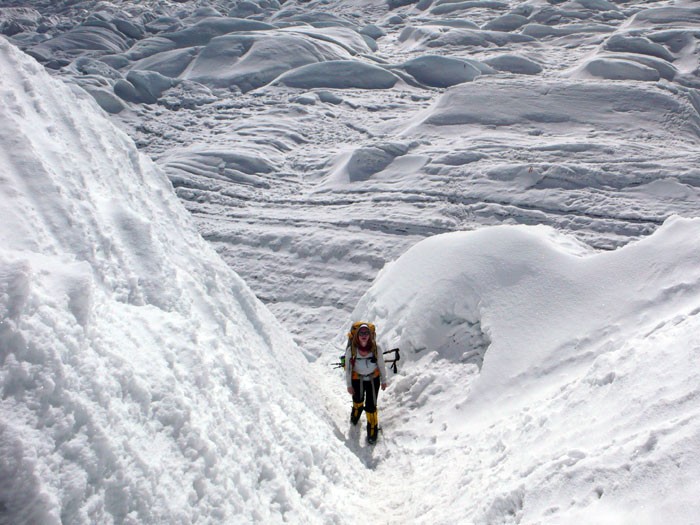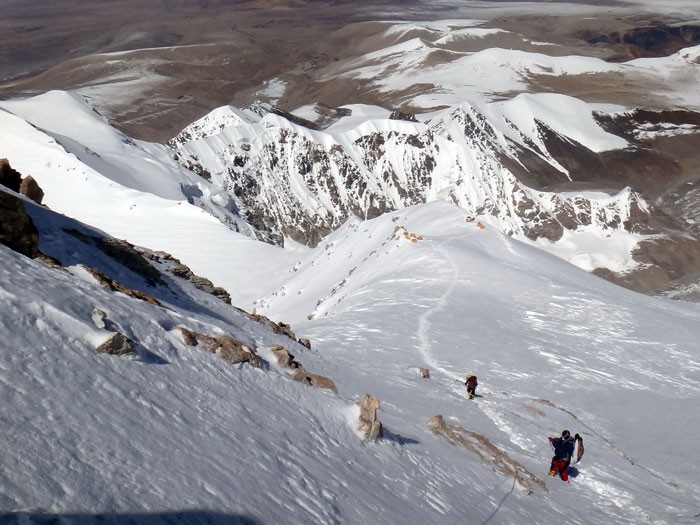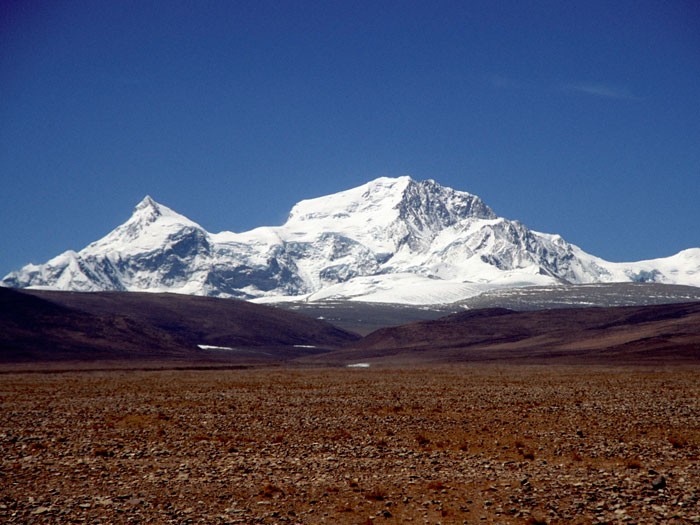Shishapangma - Tibet
Shishapangma, known in Tibetan as "the god of the grasslands", is the lowest of the world's fourteen 8,000 metre peaks. It is also the only 8000-meter peak located wholly in Tibet, and has only been opened to foreign climbers since 1978. At 8,027 metres (26,289 feet), Shishapangma, is a great introduction to large Himalayan peaks that is easy enough to ski or snowshoe.
Shishapangma - Tibet Expedition Cost
Our full-service expedition includes:
- British, American, or European leader/coordinator
- Expert Sherpa from Nepal
- Transportation and equipment carriage from Kathmandu to base camp and back
- Three meals each day
- Permit fees and liaison officers
- Group emergency equipment and satellite phone
- Private tents in basecamp (no sharing)
- Full base camp with dinning tent, showers, bathroom, and solar charger
- Double occupancy tents above base camp
- Two nights stay in Kathmandu hotel on arrival and two nights prior to departure in a double room. Private rooms are available for a small additional fee.
- Airport Transfer
What is not included?
- International flights to/from Kathmandu
- Mountain climbing rescue and travel insurance
- Personal climbing/trekking equipment and clothing
- Nepalese and Tibetan visas
- Gratuities for staff (Click here for more information)
- Oxygen (available upon request)
- Private Sherpa (personal guide/porter) – Carries up to 10 kg (22bs) of your personal equipment, climbs with you, helps with clipping and unclipping from the fixed lines at each anchor, and will be with you every step of the way.
- Personal equipment carriage service – Sherpa carry up to 10kg (22lbs) of personal equipment up and down the mountain between camps
Oxygen: You should consider whether or not you wish to use supplemental oxygen, which is optional on Cho-Oyu. Approximately half of our member choose to use oxygen. Click here for prices
We recommend a three bottle set for Cho-Oyu. The price includes three large 4 litre Russian Oxygen bottles, mask, regulator, hoses, as well as carriage to the high camps by porters. Extra bottles are available for an additional fee. We have a 30% buy-back policy on masks, regulators, and unused oxygen bottles in good condition.
Oxygen supplies may be purchased separately. The same buy-back policy applies.The following may be purchased individually:
- Mask and Hoses which are guaranteed to be in proper working order and match the bottles and regulator.
- Regulator for high-altitude oxygen bottle
- 4 litre Russian Oxygen bottle for high-altitude climbing
Shishapangma - Tibet Expedition Itinerary
- 1) Arrive in Kathmandu, 1,350 meters (4,428 feet). Our staff will meet you at the airport. Stay at hotel.
- 2) Go to Chinese embassy, for visa. Logistics, orientation meeting, purchasing, packing. Stay at hotel.
- 3) Early morning drive to Rusuwaghadi, 2,557 metres, (8,389 feet). Stay at hotel.
- 4) Enter Tibet, drive to Gyirong, 2,700 metres(8,858 feet) Stay at hotel.
- 5) Rest & acclimatization in Gyirong. Walk around the local hills. Stay at hotel.
- 6) Drive to Tingri, 4,300 meters (14,108 feet). Stay at hotel.
- 7) Rest & Acclimatization in Tingri.Stay at hotel
- 8) Drive to Chinese Base, 5,000 metres (16,404 feet). Camp
- 9) Rest at Chinese Base
- 10) Walk halfway to advanced base camp. Camp at 5,200 metres (17,060 feet).
- 11) Rest day at "interim-camp"
- 12) Walk to advanced base camp at 5,400 metres (17,717 feet).
- 13) Rest, training, and organization at advanced base camp
- 14) Walk to camp 1, 6,200 metres (20,341 feet). Return to advanced base camp.
- 15) Rest in advanced base camp
- 16) Walk to camp 1, Sleep there.
- 17) Walk to Camp 2, 6,700 metres (21,982 feet). Return to advanced base camp.
- 18) Rest in advanced base camp.
- 19) Rest in advanced base camp.
- 20) Walk to camp 1 and sleep there.
- 21) Walk to camp 2 and sleep there.
- 22) Walk to camp 3, 7,400 metres (24,278 feet). Return to advanced base camp.
- 23) Rest in advanced base camp.
- 24) Rest in advanced base camp.
- 25) Walk to camp 1 and sleep there.
- 26) Walk to camp 2 and sleep there.
- 27) Walk to camp 2 and sleep there.
- 28) Walk to camp 3 and sleep there.
- 29) Summit attempt
- 30) Summit attempt
- 31) Summit attempt
- 32) Summit attempt, descend to camp 2.
- 33) Descend to advanced base camp, pack, and prepare to depart.
- 34) Walk down to Chinese base.
- 35) Early morning drive to Gyirong. Stay at hotel.
- 36) Early morning drive to Kathmandu. Stay at hotel.
- 37) Final packing, celebration, saying goodbye to new friends. Stay at hotel
- 38) Fly home. Thank you for joining our Shisha Pangma Expedition. Shishapangma itinerary for combined Cho Oyu expedition:
9-23 October (days 1-3 below are the last 3 days of the regular Cho Oyu itinerary).
- 1) Arrive in Kathmandu after finishing Cho Oyu. Give passport to Chinese embassy for visa number 2.
- 2) Rest in Kathmandu.
- 3) Drive to Gyirong.
- 4) Rest in Gyirong.
- 5) Drive to basecamp.
- 6) Walk to advanced basecamp.
- Climb Shishapangma.
- Climb Shishapangma.
- Climb Shishapangma.
- Climb Shishapangma.
- Climb Shishapangma.
- Climb Shishapangma.
- Climb Shishapangma.
- Climb Shishapangma.
- Walk down to basecamp.
- Drive to Gyirong.
- Drive to Kathmandu.
- In Kathmandu (extra day).
- Fly home.
Shishapangma - Tibet Expedition Leadership and Staff
Leadership: Dan Mazur is a relaxed, friendly, well organized, and highly skilled professional with over 20 years of experience leading people to the summits of Everest, K2, Broad Peak, Gasherbrum, Cho Oyu, Lhotse, Manaslu, and Shishapangma.
Sherpas: We employ some of Nepal, Tibet, and the Karakorum’s best local mountaineers and Sherpas to assist team members in realizing their summit goals. Our friendly and loyal high altitude climbing staff has supported teams to the summits of more than ten of the highest peaks in the Himalaya.
Shishapangma - Tibet Expedition Personal and Team Equipment
Climbing:
- Climbing harness
- 5 meters (16 ft.) of 6mm accessory cord
- Figure 8 abseil/belay device (tube style devices, i.e. ATC will not work on fixed lines)
- Full size ascender (i.e. PetzlAscention)
- 2 locking carabiners, 1 large and 1 small
- 4 non-locking carabiners
- Ice axe with leash
- Steel crampons with anti-balling plates
- Trekking poles
- Abseiling/Rappelling Gloves
Upper Body:
- 2 cotton t-shirts
- 2 synthetic t-shirts
- 2 long sleeve synthetic shirts
- Light-weight soft shell jacket
- Medium weight insulatingjacket (fleece, down, or synthetic)
- Hard shell jacket with hood, waterproof and breathable (Gore-Tex or similar)
- Heavy down coat
- For 6,000m peaks a very warm down coat with hood or an 8,000m coat with hood
- For 7,000m peaks an 8,000m coat with hood
- For 8,000m peaks an 8,000m down coat with hood or an 8,000m suit can be used instead
Hands:
- Lightweight poly-liner gloves
- Mid-weight soft shell gloves – water/wind resistant
- Heavy- weight waterproof gloves – Gore-tex shell with removable liner
- Expedition weight mittens -Gore-tex over mitt matched polar fleece mitt liner
Head:
- Helmet
- Warm hat that covers your ears
- Balaclava
- Face mask
- Baseball hat or brimmed sun hat
- Glacier sunglasses with side shields
- Ski goggles with light and dark lenses
- Glasses with clear lenses to protect your eyes while climbing to the summit on windy nights. (cost less than 10 dollars in Kathmandu)
- Headlamp with extra batteries and bulbs
- Buff/neck gaiter
- Bandana or head scarf (optional)
Lower Body:
- Synthetic underwear
- Hiking shorts
- Hiking pants
- 2 pair lightweight thermal bottoms
- Medium or expedition weight thermal bottoms
- Polar fleece or soft shell pants
- Waterproof/breathable pants with full side zips (Gore-Tex or similar)
- Heavy insulating pants
- For 6,000m peaks: Down or synthetic pants will full zips
- For 7,000m peaks: 8,000m down pants
- For 8,000m peaks: 8,000m down pants or a 8,000m suit can be used instead
Feet:
- Boots
- For 6,000m peaks: Plastic or composite double boots (Koflach, La SportivaSpantik, etc) Modern waterproof, single boots designed for 4-5,000m peaks may be suitable if they can be worn with 2 pairs of socks and vapor barrier lines and/or they are equipped with overboots
- For 7,000m: Plastic or composite double boots (Koflach, La SportivaSpantik, etc)
- For 8,000m peaks: 8,000m boots - One-Sport Millet Everest boots or equivalent
- Sturdy leather walking boots
- Trainers, running shoes and/or sandals
- Down booties (optional)
- 3 pair med-heavy poly or wool socks
- 2 pair poly or wool liner socks (optional)
- Vapor barrier liner socks (optional)
- 2 pair lightweight trekking socks
- Cotton socks for in town
Sleeping:
- Down sleeping bag
- For 6,000m peaks: -18C or 0F
- For 7,000m peaks:-23C or -10F (If you sleep cold consider -29C or -20F)
- For 8,000m peaks: -29C or -20F (If you sleep cold consider -40C or -40F)
- An additional down sleeping bag for basecamp for the following climbs: Everest, Lhotse, AmaDablam, Manaslu, Cho Oyu, Shishapangma, Broad Peak, K2, Gasherbrum I and II, Spantik, K2/Broad Peak Everest training climb. For Mastagata a second sleeping bag is optional, but highly recommended.
- Down base camp sleeping bag should be rated to -10C or 15F (If you sleep cold consider -18C or 0F)
- Down base camp sleeping bag should be rated to -10C or 15F (If you sleep cold consider -18C or 0F)
- 2 closed cell foam kari-mats (sleeping pads) for use in basecamp and high altitude (these can be purchased inexpensively in Kathmandu)
- High quality inflatable sleeping pad designed for cold weather (Thermarest)
- Patch kit for inflatable pad
Rucksack and Travel Bags:
- Medium rucksack/backpack (50-70 litres / 3000-4500 cubic inches, can be used as carry-on bag)
- Waterproof rucksack cover (optional)
- 2 large (120+ L / 7500+ cubic inch) duffle kit bags for clothing and equipment
- Small luggage locks for duffel kit bags
Personal Hygiene:
- Female or male hygiene supplies
- 2 tubes lip sun cream
- Large tube skin sun cream (min factor 30)
- Anti-mosquito cream
- Toothpaste/brush
- Hand sanitizer gel (small-medium bottle)
- Bar of soap small towel
- Hand wipes
- Face Mask
- Hand sanitiser
- Disposable gloves
- Disinfectant wipes
Medical:
- Small personal first-aid kit. (Simple and Light) Aspirin, first-aid tape, plasters (band-aids), personal medications, etc.
- Blister repair kit
- 10 anti-diarrhea pills
- 20 anti-headache pills
- 10 cough and/or cold medicine
- Anti-altitude sickness pills: Diamox, Acetylzolamide
- 10 Stomach antibiotics: Ciprofloxacin, etc.
- 5 Azithromycin tables
- Steri pen or bottle of water purification tablets
- Cough sweets/lozenges (Halls/Stepils)
- Earplugs
- Extra prescription glasses/contact lenses and supplies
Personal Food:
- Snack food/daily energy food
- Everest training Nepal/Tibet, AmaDablam, Baruntse: 2-4kg (4.5-9lbs)
- Spantik, Cho Oyu, Shishapangma, Mustagata, Manasu: 2-5kg (4.5-11lbs)
- Broad Peak, K2, Gasherbrum I/II, K2/Everest training, Everest, Lhotse: 3-6kg (6.5-13lbs)
- Dehydrated meals (freeze-dried dinners) for summit attempt
- Everest training Nepal/Tibet, AmaDablam: 2 meals
- Spantik, Cho Oyu, Shishapangma, Mustagata, Manasu, Baruntse: 3 meals
- Broad Peak, K2, Gasherbrum I/II, K2/Everest training, Everest, Lhotse: 5 meals
- Small roll of repair tape
- Sewing repair kit
- Cigarette lighter
- Small box matches
- Compass or GPS
- Battery powered alarm clock/watch
- Camera with extra cards and extra batteries
- Nylon stuff sacks for food and gear storage
- 2 water bottles (1 litre) wide-mouth Nalgene
- Pee bottle (1litre or larger)
- Plastic cup and spoon
- Small folding knife
- Binoculars (optional)
- 4 very large, waterproof, heavy duty disposable rubbish sacks size 150-200 litre = 40-50 gallon. These are necessary for packing. thanks
- Passport, 2 extra passport photos, flight ticket, flight itinerary
- Separate photocopies of passport and relevant visa pages, proof of insurance
- Dollars, pounds, or euros cash
- Bank/ATM/Cash and credit cards
- Bathing suit/swim suit (you never know)
- Paperback books, playing cards, ipod/mp3 player, musical instruments, extra batteries, etc.
- Travel clothes for basecamp and in town
- Umbrella (optional)
- Small solar panels for personal electronics (optional)
Oxygen:
A 5 bottle set of oxygen is included in the cost of our full service Everest, K2, and Lhotse expeditions. It may be purchased for Broad Peak, Cho Oyu, Shishapangma, and Manaslu.
Group Equipment:
We provide group gear, equipment, and supplies including: rope, ice, rock, and snow anchor protection, tents; stoves, fuel, walkie-talkie radios, bamboo marker wands, etcetera. A personal tent will be provided for each member at base camp. On the upper mountain, team members will share tents. In base camp, a shower, toilet, solar charger, and a dining tent will be provided.
You can hire or buy equipment in Kathmandu. Please see the prices here: Equipment for Climbs and Trek: Renting and Purchasing
Shishapangma - Tibet Expedition Experience and Training
Shishapangma - Tibet Photo Galley
Shishapangma - Tibet Application Forms
Please fill out an application and return it to us with your refundable ten-percent deposit to hold your place on the team.
- Application for US Team Members : PDF Form or MS Word Doc
- Application for all other Team Members : PDF Form or MS Word Doc
In addition to your application, we will need the following at least two months before the trip begins:
- Completed Payment
- Oxygen order (if any)
- Sherpa order (if any)
- Trip Registration form
- 1 Passport sized photo
- A scan of your passport identification pages
- Complete flight itinerary
- Proof of travel, accident, and repatriation insurance. We strongly recommend Global Rescue, with at least $50,000 worth of helicopter rescue insurance.
- Trip cancellation/interruption insurance is recommended
Please contact us with any questions you may have.


